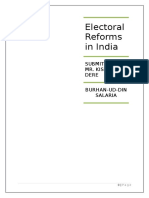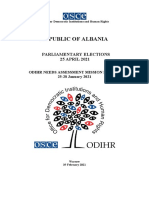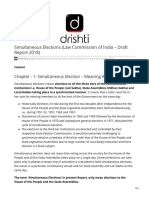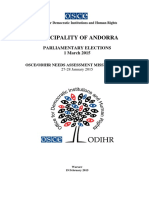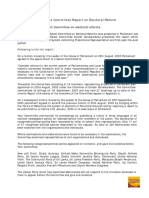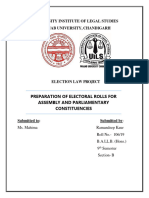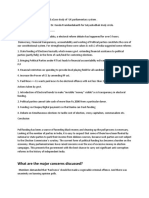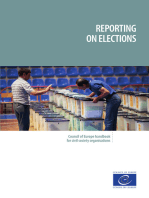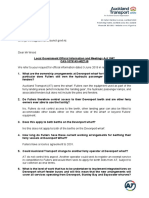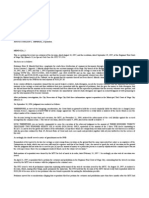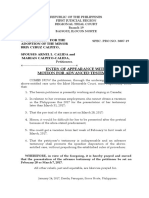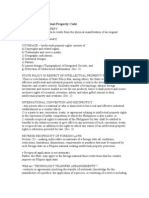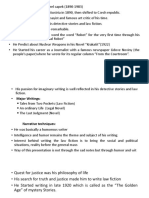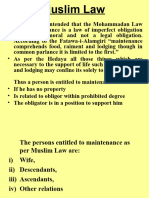Maori Seats On Auckland Council
Maori Seats On Auckland Council
Uploaded by
George WoodCopyright:
Available Formats
Maori Seats On Auckland Council
Maori Seats On Auckland Council
Uploaded by
George WoodOriginal Title
Copyright
Available Formats
Share this document
Did you find this document useful?
Is this content inappropriate?
Copyright:
Available Formats
Maori Seats On Auckland Council
Maori Seats On Auckland Council
Uploaded by
George WoodCopyright:
Available Formats
Governing Body
28 August 2014
2016 Local Government Elections - Review of Electoral System and
Review of Representation Arrangements
File No.: CP2014/18538 E
C l )
-
Purpose
1. To advise the Governing Body of the opportunity to change the electoral system for the 2016
elections, establish Maori wards and to undertake a representation review.
Executive summary
2. The Local Electoral Act 2001 provides for the opportunity to review the electoral system, the
establishment of Maori wards and a review of representation.
3. Each of these reviews has specific timeframes and processes. The Governing Body should
be aware of the implications of initiating reviews on these matters.
Recommendation/s
That the Governing Body:
i) agree that the status quo prevail for the electoral system, electoral wards and
representation.
Comments
Background
4. The Local Electoral Act 2001 provides the opportunity for local authorities to consider:
changing the electoral system (for example from FPP to STV)
establishing Maori wards
reviewing representation arrangements.
5. That Act sets out deadline dates in relation to each of these, if they are to take effect at the
next elections. A summary of these dates is:
12 September 2014 for a resolution to change the electoral system
23 November 2014 for a resolution to establish Maori wards
31 August 2015 for a resolution making the council's initial proposal on representation
arrangements.
Electoral system
6. Under the First Past the Post system (FPP) a candidate can be successful at election by
winning more votes compared to other candidates.
7. Under the Single Transferable Voting (STV) system, a voter casts a single vote but ranks his
or her preferences. First preferences are used to establish whether any candidates are
elected by reaching the required quota of votes. If not, the system provides a method for
transferring second preferences and other preferences until all vacancies are filled.
2016 Local Government Elections - Review of Electoral System and Review of Representation
Arrangements
Page 17
Governing Body
28 August 2014
An argument in favour of STV is that it is a fairer system, in that if a voter's first preference
would otherwise be wasted, the voter's second and other preferences can be recognised.
An argument against STV is that it is more complex than FPP and more difficult for voters to
understand - with a possibility of more "informal" votes (votes not properly entered so not
counted). Some councils which moved to STV have moved back to FPP, on the basis that it
is easier to understand for voters and that STV did not affect the outcome. There is some
evidence that informal votes are due to mixed electoral systems on the one voting paper,
rather than STV per se, and that when all issues on a voting paper are decided through STV
there are fewer informal votes.
9. The legislation setting up the Auckland Council prescribed FPP for the 2010 and 2013
elections: When the Auckland Governance Legislation Select Committee reported the Local
Government (Auckland Council) Bill it said:
'The majority of us are of the view that the disadvantages of STV, particularly its
perceived complexity (and therefore its propensity to discourage voting), outweigh the
disadvantages of FPP for the 2010 elections. "
10. The J ustice and Electoral Select Committee has recently published its inquiry into the 2013
local government elections. It notes the mix of FPP and STV as follows:
"Local authorities can choose between the first past the post (FPP) voting system or
STV. In 2013, 90per cent of local authorities used FPP in their own elections.
Therefore, voting in most local elections involved acombination of FPP and STV. We
understand that generally the STV councils have ahigher turnout, but the incidence of
invalid voting is usually far higher in District Health Board elections, because people
tick their preferred candidates rather than ranking them.
8.
In 2008, the Local Government Commission conducted apost-election survey of
voters; 52 per cent of the respondents said that having two systems was confusing,
while 46 per cent said it was not. A large majority of respondents (82 per cent) said
they would prefer asingle system."
11. The committee did not make a specific recommendation.
12. A further aspect of STV is that, on election day, the result is delayed, due to the need to
have all votes in prior to transferring preferences.
13. The guidelines issued by the Local Government Commission state:
'The Commission notes, for example, the argument that to gain the full benefits of
proportional representation under STV, multi-member wards or constituencies of at
least three members, but preferably five to seven members, are required. Clearly this
should be considered by alocal authority using STV when undertaking its
representation review. "
14. Governing Body member wards are either one member or two member wards, and therefore
STV would not likely have a significant impact.
15. Local boards are multi-member bodies and local board members were invited to a briefing
on these issues. There was not a strong desire expressed for change.
16. Whether or not the council resolves to change the electoral system, it must give public notice
of the right of electors to demand a poll.
2016 Local Government Elections - Review of Electoral System and Review of Representation
Arrangements
Page 18
Governing Body
28 August 2014
Maori wards
17. The Royal Commission on Auckland Governance recommended a Governing Body E
comprising of the mayor and 23 councillors, two of whom would be elected at large from the c u
Maori electoral role and one of whom would be appointed by Mana Whenua. :::
18. However, Parliament legislated for a Governing Body comprising of the mayor and 20
councillors with no Maori seats and the creation of an Independent Maori Statutory Board
(IMSB).
19. Nevertheless, the general provisions of the Local Government Act 2002 with respect to
Maorl wards still apply to Auckland Council. Thus, as the legislation stands, the IMSB would
continue to exist if Maori wards were established.
20. The legislation provides for councils to establish Maort wards by passing a resolution by
23 November 2014. This is discretionary, council is not required to take any action
21. On the basis of statistics supplied by Statistics New Zealand, two members of Auckland
Council could be elected through Maori wards. The total number of Governing Body
members is set in legislation at 20 plus the mayor and so the number of general members
would be reduced to 18 if Maori wards are established. There could be two separate Maori
wards with one member elected in each, or there could be one Auckland-wide ward with two
members.
22. Should the Council resolve to introduce Maori wards then the timeframes are as follows.
8y23 A local authority MAY resolve to introduce Maori Section 19Z of LEA
November representation for the next triennial election.
2014 If a resolution is made after this date then it takes
effect at the subsequent triennial election.
It has effect for two triennial elections and continues
unless changed.
8y30 IF a resolution has been made by a local authority to Section 19ZA of LEA
November introduce Maon representation, a local authority
2014 MUST give public notice of the right of 5per cent of
the electors to demand a poll on Maori
representation.
By 28 IF a resolution has been made by a local authority to Section 19ZC of LEA
February introduce Maori representation, a certain period
2015 MUST be given following the public notice on Maori
representation allowing electors to gather sufficient
signatures to demand that a poll be held on Maori
representation for the next two triennial elections.
By28 A local authority MAY resolve to undertake a poll of Section 19ZD of LEA
February electors on a proposal that Maori representation be
2015 introduced for the next two triennial elections.
23. Through various engagement and consultation processes there has been a call for direct
Maori representation on the Governing Body and greater involvement by Maori in council
decision making processes.
2016 Local Government Elections -Review of Electoral Systemand Review of Representation
Arrangements
Page 19
Governing Body
28 August 2014
24. This is reflected in the IMSB's schedule of issues of significance and Maori Plan:
"Meori are empowered, enabled, respected and recognised in their ability to actively
and meaningfully contribute to the development of Auckland, in becoming the world's
most liveable city by acouncil that actively engages, consults and includes Maori in
decision making processes and future plans".
"Maori are empowered, enabled, respected and recognised as playing an important
role in the development of local communities by acouncil that recognises the role of
Maori in local board decision making".
25. In the IMSB's view the establishment of Maori wards are an important part of contributing to
these outcomes. The board is of the view that direct representation on the Governing Body
through Maori wards is distinct from the IMSB's role as an independent statutory authority.
From the board's perspective the two roles are not mutually exclusive.
26. The establishment of up to two Maori wards, would have the effect of triggering a
representation review. The transfer of Maori voters from the general roll to the Maori roll,
would impact on the remaining number of voters in each general ward in a manner that
would not be uniform. This would affect the plus or minus 10 per cent rule and mean the
redrawing of most, if not all, ward boundaries. The Governing Body ward boundaries would
then not be contiguous with local board boundaries unless they were to be reviewed as a
consequence.
27. The representation review provisions which apply to councils generally and to Auckland
Council's Governing Body with respect to ward boundary changes do not apply for local
board boundary changes. Proposed changes to local board boundaries must be dealt with
as a reorganisation proposal in the same manner as proposed boundary changes between
local authorities.
28. The following section of this report draws the conclusion that there are no compelling
reasons to undertake a representation review for the 2016 election, although one must be
undertaken for the 2019 election. However, the establishment of Maor! wards would result
in such a review being undertaken for 2016 and is therefore not recommended.
29. If the council were of a mind to consider the establishment of Maori wards in the future it
may well want to consider advocating changes to legislation as to the maximum number of
members, and the process for considering local board boundaries. Such a review could not
be completed within the timeframe required for the 2016 elections.
Review of representation arrangements
30. Each territorial and regional council must conduct a review of representation arrangements
at least once every six years. If the council decides to not conduct a review for the 2016
elections, it must conduct a review for the 2019 elections.
31. If the council decides to conduct a review, it must resolve its initial proposal by 31 August
2015. Investigations would need to commence this calendar year to meet that deadline.
32. The total number of members of the Governing Body is set by legislation. The review could
propose to amend the number, names and boundaries of wards; the number and names of
local board subdivisions and the number of local board members in each board. As stated
above the boundaries of local boards can only be changed through a reorganisation
process.
2016 Local Government Elections -Review of Electoral System and Review of Representation
Arrangements
Page 20
Governing Body
28 August 2014
33. The legislation requires effective representation of communities of interest and fair
representation (the people represented by each councillor should not deviate from the
average by more than 10 per cent). When the Local Government Commission set the
current boundaries it accepted some deviations over the 10 per cent threshold. The
commission was directed by legislation to create a single member ward for the former
Rodney district and a single member ward for what remained of the Franklin district after the
southern part of the district was transferred to Waikato District Council. On current statistics,
there would be an under-representation problem in the Waitemata ward. This is primarily
brought about by the number of residents now residing in apartments in the CBD and CBD
fringe. Attached is a table of changes based on information from the 2013 census.
34. Adjusting the boundary of the Albert-Eden-Roskill boundary to include some of the current
Waitemata ward could address this variance. Changing the boundaries of one ward can
have a flow-on effect into other wards.
The timeframes should the council choose to undertake a review this term are as follows.
By 31 August 2015 Representation Arrangements Review Section 19H of LEA
completed by local authority. Local
authority resolves its proposals.
By 8 September 2015 A local authority MUST give public notice of Section 19M of LEA
the resolution containing the representation
arrangements reviewproposals. One month
submission period.
By 8 October 2015 Close of submissions. Section 19M of LEA
By 19 November 2015 Submissions heard by local authority. Section 19N of LEA
By 19 November 2015 A local authority MUST give further public Section 19N of LEA
notice of its proposals. One month
appeals/objection period.
By 19 December 2015 Close of appeals/objections. Section 190 of LEA
By 15 January 2016 Forward all representation and boundary Section 19Q of LEA
reviewmaterial to LGC (if
appeals/objections received).
By 10 April 2016 Determination by LGC Section 19R of LEA
We are not aware of significant problems with the current arrangements and do not intend to
recommend a review for the 2016 elections.
Consideration
Local board views and implications
35. A workshop was held for local board members. Those attending did not express a desire for
change in relation to the electoral system. The Waitakere Ranges Local Board has also
advised their preference for maintaining status quo (WTKl2014/11 0).
Maori impact statement
36. There has been no consultation with Maori specifically in relation to this report. However,
the matter has been raised through previous engagement processes and been the subject of
advocacy to the council by the IMSB (see paragraphs 23-25).
2016 Local Government Elections - Review of Electoral System and Review of Representation
Arrangements
Page 21
Governing Body
28 August 2014
37. Maori wards are one mechanism for increasing Maori participation in council decision
making. However, there are a range of other mechanisms which are not reliant on a
representation review. These are the subject of advocacy through the IMSS's schedule of
significance and Maori Plan, and the council is actively striving to advance enhanced
involvement in decision making through a range of initiatives.
Implementation
38. If the Governing Body resolves to change from FPP to STY, the council's current provider of
election services will be able to make the appropriate Changes.
39. There would need to be an extensive awareness campaign to ensure all voters were aware
of the change.
40. The cost of a poll would be in the order of one million dollars.
Attachments
I
-NO-- --1 -1 T_itle 1pa
g
2
e
3
1
A Wards 2010 and 2013 . .
Signatories
Author Warwick McNaughton - Principal Advisor - Democracy Services
Authorisers Grant Taylor - Governance Director
Stephen Town - Chief Executive
2016 Local Government Elections - Review of Electoral System and Review of Representation
Arrangements
Page 22
Governing Body
28 August 2014
Wards in 2010 and after the 2013 census results.
%dttvl ation
from Gl IW.age
p6WOOl otl
pet,
tou ndl l ot
%d v 'Uonfr:om
a\/egge
population por
l ;:O!.l l l C l l (l ('
No. or
cwndtlol"1ll
PfII'wl u d 201 3
201 3
Ro d n e y 54,1 00 -24.B 54.B79 -22.5
Albany 137,800 2 -4.2 1 43,502 +1.4
<C
-
~
NortihShore 1 43.200 2 -0.5 1 37,961 -2.5
Q)
E
..c :
(J
Waitakere 1 58,700 2 +10.3 1 56,081 +10.3
ns
-
-
<C
Whau 76.400 1 +6.2 1 2,594 2B
Albert-Eden-Roskill 1 54,900 2 +7.7 1 47,633 +4.3
Wail.emata and Gulf 79.300 +10,2 86.41 5 +22.1
Orakes 81 ,1 00
+12.8 79.539 +12.4
Maungakiekie-
Tamaki
73,000 +1.5 70.002
,
2016 Local Government Elections - Review of Electoral System and Review of Representation
Arrangements
Page 23
Governing Body
Auckland ~t1
28 August 2014 _9~~~::
C D
~
E
Q)
Howtck 1 28.1 00 2 -10.9 1 27.1 25 -10.2
~
Manukau 156,200 2 8 . 6 146,622 +3.6
Manurewa-Papakura 131.500 2 -8.6 1 27.878 -9.7
Fmnklin 64.200 1 -1 0.1 65,31 9 -7.7
Total 1 ,438,500 20 1 ,41 5,550
....
c ::
Q)
E
s:
o
c a
....
...
2016 Local Government Elections - Review of Electoral System and Review of Representation
Arrangements
Page 24
You might also like
- Sales Agreement Fix Uas GlobalDocument5 pagesSales Agreement Fix Uas Globalsulistyo rachmad wibowoNo ratings yet
- Chineasy Everyday Learning Chinese Through Its Culture - Qelxr0xDocument2 pagesChineasy Everyday Learning Chinese Through Its Culture - Qelxr0xNina WatanabeNo ratings yet
- Billboard LUC60368727 Decision Jan 2022Document35 pagesBillboard LUC60368727 Decision Jan 2022George WoodNo ratings yet
- Maribel Sarante v. City of New York, Et Al.Document21 pagesMaribel Sarante v. City of New York, Et Al.Eric SandersNo ratings yet
- Summary Procedure V Small ClaimsDocument2 pagesSummary Procedure V Small ClaimsNombs Nom100% (1)
- Parliamentary Report On The Uganda Local Government (Amendment) Bill, 2016Document22 pagesParliamentary Report On The Uganda Local Government (Amendment) Bill, 2016African Centre for Media ExcellenceNo ratings yet
- Report of The Electoral Commission On THDocument79 pagesReport of The Electoral Commission On TH1231302136No ratings yet
- uzbekistan NAMDocument15 pagesuzbekistan NAMMiloš AntićNo ratings yet
- Simultaneous Election To Lok Sabha and State Legislative AssembliesDocument11 pagesSimultaneous Election To Lok Sabha and State Legislative AssembliesDharmin DesaiNo ratings yet
- Electoral Reforms in IndiaDocument6 pagesElectoral Reforms in IndiaKartik DubeyNo ratings yet
- Eclectroal Reforms in India - Election LawDocument20 pagesEclectroal Reforms in India - Election LawNandini TarwayNo ratings yet
- Elections and Electoral ReformsDocument6 pagesElections and Electoral ReformsJannat100% (1)
- Representation of People ActDocument17 pagesRepresentation of People ActAnjaliNo ratings yet
- ELECTION COMMISION PPT NasebDocument12 pagesELECTION COMMISION PPT Nasebss8795082No ratings yet
- Electroral Reforms 3Document20 pagesElectroral Reforms 3AaroNo ratings yet
- Zgjedhjet e 25 Prillit/ Raporti I ODIHR: Vëmendja Te Identifikimi Biometrik, Ja Sa Vëzhgues Do KemiDocument16 pagesZgjedhjet e 25 Prillit/ Raporti I ODIHR: Vëmendja Te Identifikimi Biometrik, Ja Sa Vëzhgues Do KemiOra News LajmeNo ratings yet
- Election CommisionDocument16 pagesElection CommisionPraveen chouhanNo ratings yet
- Board of Elections: Resident Xecutive IrectorDocument7 pagesBoard of Elections: Resident Xecutive IrectorCeleste KatzNo ratings yet
- Election Commission: Model Code of ConductDocument8 pagesElection Commission: Model Code of ConductRitu MadanNo ratings yet
- The 2013 Municipal Election:: An Analysis & RecommendationsDocument39 pagesThe 2013 Municipal Election:: An Analysis & Recommendationseric_roperNo ratings yet
- Boundary Review PAPER DDocument5 pagesBoundary Review PAPER DOnTheWightNewsNo ratings yet
- Electoral Reforms in Pakistan 2017Document7 pagesElectoral Reforms in Pakistan 2017Hamza UsmanNo ratings yet
- Teaching Assistant, Department of Political Science, Shivagan-Gotri, Davangere University, Davangere-577 002Document2 pagesTeaching Assistant, Department of Political Science, Shivagan-Gotri, Davangere University, Davangere-577 002HrishikeshNo ratings yet
- Screenshot 2023-08-06 at 10.30.13 PMDocument3 pagesScreenshot 2023-08-06 at 10.30.13 PMkumba.lenaNo ratings yet
- Raporti I OSBE-ODIHRDocument16 pagesRaporti I OSBE-ODIHRRtsh FaqeNo ratings yet
- Lco500 2023 01 AfDocument9 pagesLco500 2023 01 AfElmari Mynhardt CoetzeeNo ratings yet
- Process of ElectionsDocument4 pagesProcess of Electionspriya jainNo ratings yet
- Simultaneous Elections Law Commission of India Draft Report 2018Document25 pagesSimultaneous Elections Law Commission of India Draft Report 2018jaishree singhNo ratings yet
- Opinie Promo-LEX Referendum-Alegeri 20.11.2018 Eng2Document11 pagesOpinie Promo-LEX Referendum-Alegeri 20.11.2018 Eng2Anonymous Q3ehuGNNo ratings yet
- ANNUAL ReportDocument61 pagesANNUAL ReportTuta ChkheidzeNo ratings yet
- The Afghanistan Electoral SystemDocument21 pagesThe Afghanistan Electoral SystemAdnan Yusufzai100% (1)
- Electroral Reforms 1Document20 pagesElectroral Reforms 1AaroNo ratings yet
- Principality of Andorra: Parliamentary Elections 1 March 2015Document11 pagesPrincipality of Andorra: Parliamentary Elections 1 March 2015Kai SanNo ratings yet
- Election ProcessDocument7 pagesElection ProcessDerrick Chan Yew Weng100% (1)
- 150428160429dinesh Gunawardena Report Interim Report of Select Committee On Electoral ReformsDocument6 pages150428160429dinesh Gunawardena Report Interim Report of Select Committee On Electoral ReformstfmlankaNo ratings yet
- Recommendations, Bills and Government Agenda On Political and ElectDocument9 pagesRecommendations, Bills and Government Agenda On Political and ElectManuel L. Quezon III100% (1)
- Charter Commission ChoiceDocument1 pageCharter Commission Choiceapi-417098742No ratings yet
- EMDS Final Report 2010 - AzerbaidjanDocument50 pagesEMDS Final Report 2010 - AzerbaidjankuseaNo ratings yet
- University Institute of Legal Studies Panjab University, ChandigarhDocument17 pagesUniversity Institute of Legal Studies Panjab University, ChandigarhsssNo ratings yet
- Electoral ReformDocument5 pagesElectoral Reformdrmagithomas99No ratings yet
- bosnia NAM 2024Document18 pagesbosnia NAM 2024Miloš AntićNo ratings yet
- ERO HandbookDocument204 pagesERO HandbookEr Aishwarya Rajesh NalegaonkarNo ratings yet
- Notes The Representation of The People Act, 1951 (An Analysis)Document11 pagesNotes The Representation of The People Act, 1951 (An Analysis)Sreekanth Reddy100% (1)
- Article 243K & 243ZA of Cons Tit Ion of IndiaDocument12 pagesArticle 243K & 243ZA of Cons Tit Ion of Indiarajeshtripathi75588No ratings yet
- georgia NAM 2024Document18 pagesgeorgia NAM 2024Miloš AntićNo ratings yet
- Ifes Faqs Elections in Albania 2021 Parliamentary Elections April 2021Document12 pagesIfes Faqs Elections in Albania 2021 Parliamentary Elections April 2021ab theproNo ratings yet
- Volt ElectDocument17 pagesVolt Electganabot256No ratings yet
- Election Commission of IndiaDocument5 pagesElection Commission of IndiaSarvesh JaiswalNo ratings yet
- To: The OSCE Office For Democratic Institutions and Human Rights (ODIHR)Document2 pagesTo: The OSCE Office For Democratic Institutions and Human Rights (ODIHR)Erjon DervishiNo ratings yet
- Elections: All Members of The Three Levels of Panchayati Raj Institutions Are Elected Directly by The People. TheDocument7 pagesElections: All Members of The Three Levels of Panchayati Raj Institutions Are Elected Directly by The People. TheSainath SindheNo ratings yet
- Election CommissionDocument8 pagesElection CommissionMirza Arbaz BegNo ratings yet
- Election CommissionDocument8 pagesElection CommissionAnkita SinghNo ratings yet
- ERO HandbookDocument267 pagesERO HandbookSaket AmbarkhaneNo ratings yet
- 2024-04-26 WatermarkDocument56 pages2024-04-26 WatermarkAnanya SoniNo ratings yet
- Interim Report Into Polling Station QueuesDocument39 pagesInterim Report Into Polling Station QueueshelenduffettNo ratings yet
- E2014 Ge1Document280 pagesE2014 Ge1Mohamed Rashid RaashiNo ratings yet
- Electroral ReformsDocument14 pagesElectroral ReformsManohar KakadeNo ratings yet
- Electoral Reforms Issues and Challenges Before Election CommissionDocument18 pagesElectoral Reforms Issues and Challenges Before Election CommissionSrinjoy DeyNo ratings yet
- Regulating Referenda in EuropeDocument45 pagesRegulating Referenda in EuropeCentar za ustavne i upravne studijeNo ratings yet
- Election Commission of IndiaDocument41 pagesElection Commission of Indiatps_1aathi8017No ratings yet
- Joint Resolution To Put Non-Partisan Redistricting Before WI VotersDocument1 pageJoint Resolution To Put Non-Partisan Redistricting Before WI VotersCommonCauseWINo ratings yet
- India Is The Largest Democracy in The WorldDocument3 pagesIndia Is The Largest Democracy in The WorldLeah DavisNo ratings yet
- The Constitution of Sint Maarten: When It Is Time to VoteFrom EverandThe Constitution of Sint Maarten: When It Is Time to VoteNo ratings yet
- Reporting on elections: Council of Europe handbook for civil society organisationsFrom EverandReporting on elections: Council of Europe handbook for civil society organisationsNo ratings yet
- Colour Submission DTLB Sub RepresentationReview2024Document16 pagesColour Submission DTLB Sub RepresentationReview2024George WoodNo ratings yet
- Bayswater Marina - Decision COMBINEDDocument221 pagesBayswater Marina - Decision COMBINEDGeorge WoodNo ratings yet
- Motels Used As Emergency Housing Minutes of Devonport-Takapuna Local Board - Tuesday, 16 February 2021Document1 pageMotels Used As Emergency Housing Minutes of Devonport-Takapuna Local Board - Tuesday, 16 February 2021George WoodNo ratings yet
- Wallace V Auckland Council 2021 NZHC 3095Document78 pagesWallace V Auckland Council 2021 NZHC 3095George WoodNo ratings yet
- William Souter Stormwater Upgrade 1Document2 pagesWilliam Souter Stormwater Upgrade 1George WoodNo ratings yet
- Kerbside Agenda of Extraordinary Finance and Performance Committee - Wednesday, 8 December 2021Document102 pagesKerbside Agenda of Extraordinary Finance and Performance Committee - Wednesday, 8 December 2021George WoodNo ratings yet
- Wairau Creek Report FINAL Sept 2020Document49 pagesWairau Creek Report FINAL Sept 2020George Wood100% (1)
- Agenda of Devonport-Takapuna Local Board - Tuesday, 18 May 2021 Page 11 NoMDocument1 pageAgenda of Devonport-Takapuna Local Board - Tuesday, 18 May 2021 Page 11 NoMGeorge WoodNo ratings yet
- Agenda of Devonport-Takapuna Local Board - Tuesday, 16 November 2021Document64 pagesAgenda of Devonport-Takapuna Local Board - Tuesday, 16 November 2021George WoodNo ratings yet
- DTLB Resolutions 2016-19 Re Lake RDDocument5 pagesDTLB Resolutions 2016-19 Re Lake RDGeorge WoodNo ratings yet
- Sunny No Ok Plan 2018Document23 pagesSunny No Ok Plan 2018George WoodNo ratings yet
- Emergency Budget 2020/2021: o e Er e Can Recover S RongerDocument34 pagesEmergency Budget 2020/2021: o e Er e Can Recover S RongerGeorge WoodNo ratings yet
- Auckland Transport CAS 1079143 H0Z7J9Document2 pagesAuckland Transport CAS 1079143 H0Z7J9George WoodNo ratings yet
- Ian Handley Before His Move To The Waikato NSTA Mar 19, 2002 p2Document1 pageIan Handley Before His Move To The Waikato NSTA Mar 19, 2002 p2George WoodNo ratings yet
- NoM Agenda of Devonport-Takapuna Local Board - 19 May 2020Document4 pagesNoM Agenda of Devonport-Takapuna Local Board - 19 May 2020George WoodNo ratings yet
- Agenda of Devonport-Takapuna Local Board Community Forum - 25 August 2020Document15 pagesAgenda of Devonport-Takapuna Local Board Community Forum - 25 August 2020George WoodNo ratings yet
- Lake RD DBC Consultation Report Final June 2020Document62 pagesLake RD DBC Consultation Report Final June 2020George WoodNo ratings yet
- Tetra+Traps SpecificationsDocument1 pageTetra+Traps SpecificationsGeorge WoodNo ratings yet
- Milford Estuary Wairau Estuary Sediment Management 2015Document46 pagesMilford Estuary Wairau Estuary Sediment Management 2015George WoodNo ratings yet
- Sunnynook Road - PowerPoint PresentationDocument11 pagesSunnynook Road - PowerPoint PresentationGeorge WoodNo ratings yet
- Woolworths New Zealand Limited V Alcohol Regulatory and Licensing Authority (2020) NZHC 293 (27 February 2020) PDFDocument44 pagesWoolworths New Zealand Limited V Alcohol Regulatory and Licensing Authority (2020) NZHC 293 (27 February 2020) PDFGeorge WoodNo ratings yet
- The Takapuna Centre Plan 2014Document19 pagesThe Takapuna Centre Plan 2014George WoodNo ratings yet
- Northern Busway Review Report 2012Document32 pagesNorthern Busway Review Report 2012George WoodNo ratings yet
- Takapuna Beach Holiday Park Agenda of Devonport-Takapuna Local Board - 21 May 2019Document19 pagesTakapuna Beach Holiday Park Agenda of Devonport-Takapuna Local Board - 21 May 2019George WoodNo ratings yet
- Structures of Violence: The Indian State in Jammu and KashmirDocument549 pagesStructures of Violence: The Indian State in Jammu and KashmirNagesh Rao100% (1)
- 32 - Maralit vs. ImperialDocument3 pages32 - Maralit vs. ImperialClaribelle Dianne Rosales ManriqueNo ratings yet
- MotorDocument23 pagesMotorMARUTHINo ratings yet
- Module 2Document2 pagesModule 2hilldeguzman510No ratings yet
- MSA Attribute Kappa 01Document7 pagesMSA Attribute Kappa 01JAVIERNo ratings yet
- Airbnb Rental AgreementDocument5 pagesAirbnb Rental AgreementCyuzuzo EmmanuelNo ratings yet
- Procurement Organizational Structure - Bukidnon2ndDocument11 pagesProcurement Organizational Structure - Bukidnon2ndJessica Christine Duetes DumasNo ratings yet
- R e S T R I C T e DDocument8 pagesR e S T R I C T e Dgilbertmendova3No ratings yet
- 124844-1997-Manacop v. Court of Appeals PDFDocument7 pages124844-1997-Manacop v. Court of Appeals PDFEnyong LumanlanNo ratings yet
- Sarcepuedes vs. PeopleDocument1 pageSarcepuedes vs. PeopleJonathan CollinsNo ratings yet
- Law On CopyrightDocument17 pagesLaw On CopyrightJen T. TuazonNo ratings yet
- Motion For Advance TestimonyDocument2 pagesMotion For Advance TestimonyEd Von Fernandez Cid100% (1)
- Motion For Leave For Extraterritorial ServiceDocument4 pagesMotion For Leave For Extraterritorial ServiceNicole SantoallaNo ratings yet
- AIA MotorDocument2 pagesAIA MotorAzri NaimNo ratings yet
- SLU Bar Ops ReviewerDocument17 pagesSLU Bar Ops ReviewerkimhgniezkaNo ratings yet
- (d8) Philippines First Insurance Co., Inc. Vs Wallem Phils. Shipping, Inc.Document4 pages(d8) Philippines First Insurance Co., Inc. Vs Wallem Phils. Shipping, Inc.MhaliNo ratings yet
- Contoh Template IA Kerma Luar NegeriDocument17 pagesContoh Template IA Kerma Luar Negeriyovanimanuel imanuelNo ratings yet
- Mr. Havlena's Verdict PDFDocument31 pagesMr. Havlena's Verdict PDFMehre Emaan100% (6)
- 13 Full CSE Reviewer With AnswersDocument72 pages13 Full CSE Reviewer With AnswersAnonymous EvbW4o1U7No ratings yet
- Ostensible Under TpaDocument16 pagesOstensible Under TpaanamtaNo ratings yet
- Muslim Law (Case Study)Document42 pagesMuslim Law (Case Study)tinku913084No ratings yet
- Chua, Alyssa Mae R. - Private International LawDocument4 pagesChua, Alyssa Mae R. - Private International Lawjoeye louieNo ratings yet
- Forensics Sample ReportDocument7 pagesForensics Sample ReportPranjal BagrechaNo ratings yet
- Presented By:-: Ravi Shankar Dwivedy Som Shankar Rai Raju Mahato Rajesh Kumar Gond SandeepDocument19 pagesPresented By:-: Ravi Shankar Dwivedy Som Shankar Rai Raju Mahato Rajesh Kumar Gond SandeepRaju MahatoNo ratings yet
- Lead Guitar Applications 5Document48 pagesLead Guitar Applications 5oda_eterna3592No ratings yet
- GR No. 184537, April 23, 2010 Quintin Saludaga and SPO2 Fiel Genio Vs Sandiganbayan and PeopleDocument1 pageGR No. 184537, April 23, 2010 Quintin Saludaga and SPO2 Fiel Genio Vs Sandiganbayan and PeopleAlvs Loreno100% (1)










